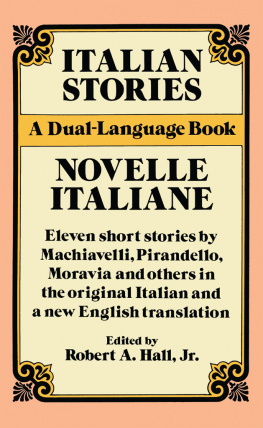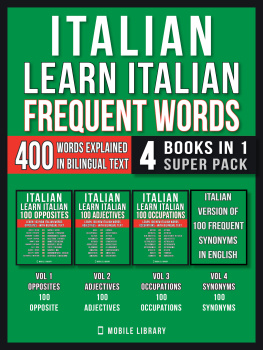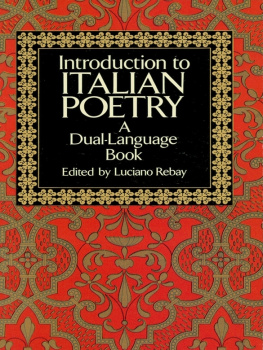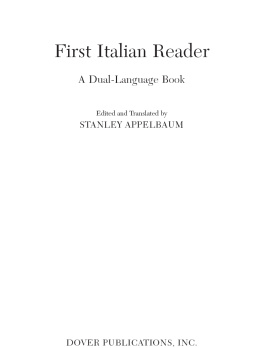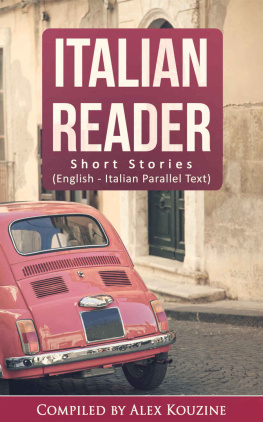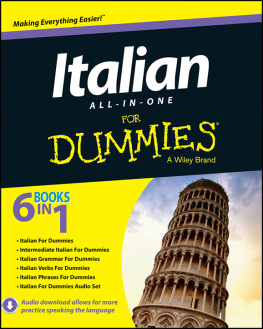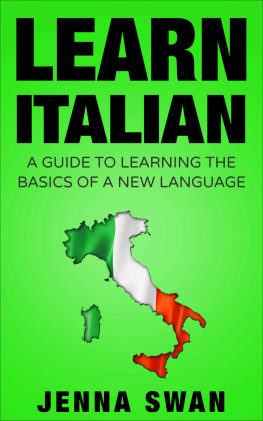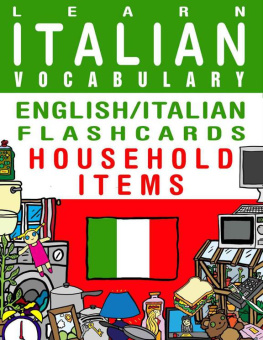Robert A. Hall - Italian Stories: A Dual-Language Book
Here you can read online Robert A. Hall - Italian Stories: A Dual-Language Book full text of the book (entire story) in english for free. Download pdf and epub, get meaning, cover and reviews about this ebook. year: 2012, publisher: Dover Publications, genre: Detective and thriller. Description of the work, (preface) as well as reviews are available. Best literature library LitArk.com created for fans of good reading and offers a wide selection of genres:
Romance novel
Science fiction
Adventure
Detective
Science
History
Home and family
Prose
Art
Politics
Computer
Non-fiction
Religion
Business
Children
Humor
Choose a favorite category and find really read worthwhile books. Enjoy immersion in the world of imagination, feel the emotions of the characters or learn something new for yourself, make an fascinating discovery.
- Book:Italian Stories: A Dual-Language Book
- Author:
- Publisher:Dover Publications
- Genre:
- Year:2012
- Rating:3 / 5
- Favourites:Add to favourites
- Your mark:
- 60
- 1
- 2
- 3
- 4
- 5
Italian Stories: A Dual-Language Book: summary, description and annotation
We offer to read an annotation, description, summary or preface (depends on what the author of the book "Italian Stories: A Dual-Language Book" wrote himself). If you haven't found the necessary information about the book — write in the comments, we will try to find it.
Eleven great stories in original Italian with vivid, accurate English translations on facing pages, teaching and practice aids, Italian-English vocabulary, more. Chronologically arranged stories by Boccaccio, Machiavelli, dAnnunzio, Pirandello and Moravia, plus significant works by lesser-knowns.
Italian Stories: A Dual-Language Book — read online for free the complete book (whole text) full work
Below is the text of the book, divided by pages. System saving the place of the last page read, allows you to conveniently read the book "Italian Stories: A Dual-Language Book" online for free, without having to search again every time where you left off. Put a bookmark, and you can go to the page where you finished reading at any time.
Font size:
Interval:
Bookmark:
ITALIAN STORIES/
NOVELLE ITALIANE
A DUAL-LANGUAGE BOOK
Edited by
Robert A. Hall, Jr.
Professor Emeritus of Linguistics and Italian
Cornell University
DOVER PUBLICATIONS, INC.
NEW YORK
LA CONCORRENZA by Alberto Moravia. From RACCONTI ROMANI . Copyright 1956, by Valentino Bompiani & Co.
MARSINA STRETTA by Luigi Pirandello. Copyright by R. Bemporad & F. 1924. Reprinted by permission of the Pirandello Estate.
ROSSO MALPELO by G. Verga, from VITA DEI CAMPI ; GLI IDOLATRI by G. dAnnunzio, from LE NOVELLE DELLA PESCARA; BISTINO E IL SIGNOR MARCHESE by A. Palazzeschi, from TUTTE LE NOVELLE ; Copyright Arnoldo Mondadori Editore.
I GIOCTTOLI ROTTI by Carlo Alvaro, from 75 RACCONTI (Milan: Bompiani, 1955) is reprinted by permission of Casa editrice Valentino Bompiani.
Copyright 1961 by Bantam Books, Inc.
Copyright renewed 1989 by Robert A. Hall, Jr.
All rights reserved.
This Dover edition, first published in 1989, is an unabridged, slightly corrected republication of the work originally published by Bantam Books, Inc., in 1961.
Library of Congress Cataloging-in-Publication Data
Italian stories.
Reprint. Originally published: New York : Bantam Books, 1961.
1. Short stories, ItalianTranslations into English. 2. Short stories, EnglishTranslations from Italian. I. Hall, Robert Anderson, 1911
PQ4254.I81989853.010889-23477
ISBN-13: 978-0-486-26180-5 (pbk.)
ISBN-10:0-486-26180-8 (pbk.)
Manufactured in the United States by Courier Corporation
26180816
www.doverpublications.com
CONTENTS
For those who are interested in this book primarily as a linguistical tool, it is suggested that the stories be read in the following order of difficulty: Moravia, Alvaro, Fucini, Palazzeschi, Pirandello, Verga, Fogazzaro, Bandello, Machiavelli, Boccaccio, dAnnunzio.
Foreword
S INCE TIME immemorial, in Italy as elsewhere, people have told each other stories about things which were new, different or interesting; hence the Italian name for such a story, novella, derived from the adjective nuovo, new. At the outset, the novella was simply a brief anecdote, told with no more artistic pretensions than the little tales which pass from one person to another by word of mouth, and depend for their effect on a brief build-up and a single concluding twist or punch-line. In medieval Europe, numerous such stories were circulating; in addition to contemporary events and personages, their subjects might include folk-tales, animal fables, and other material derived either from ancient sources or from the East, particularly the Indian story collections entitled the Panchatantra and the Hitopadea. Likewise of ultimately Indian origin was the frequently used devicefamiliar to most of us through the Arabian Nightsof unifying a collection of otherwise unrelated stories by incorporating them in the cornice or framework of still another story.
The first step towards developing the unadorned anecdote into an artistic form was taken in Italy with the two collections known as the Libro de Sette Sav (Book of the Seven Sages) and the Novellino, both of which date from the thirteenth century. The stories contained in these collections range from the brief anecdote of a single paragraph, to the more extended story. In the Libro de SetteSav, the stories, set in a framework, are traditional in subject-matter; in the Novellino, on the other hand, the tales are derived from many different sourcesclassical, Biblical, Oriental, and contemporary literature (especially the French Matire de Bretagne or Breton cycle of romances). Even in the longer stories, the narrative technique of these two collections is primitive and nave, with relatively little artistic pretensions, and represents only the first step in the development of the novella as a literary genre.
In the fourteenth century, Italy had three men who, each in a particular field of literature, created such masterpieces as to set an example for later generations and thereby exert lasting influence on literary development: Dante Alighieri (12651321) in epico-didactic poetry, Petrarch (Francesco Petrarca, 13041374) in lyric poetry, and Giovanni Boccaccio (13131375) in prose narration. Boccaccio, in his Decameron (probably written in the early 1350s), at one stroke carried the medieval novella to its furthest development as a form of art. He accomplished this by careful observation and analysis of character, especially as revealed in dialogue; and elaboration of narrative style, by imitation of Latin prose models. To his contemporaries, Boccaccios Latinizing manner seemed highly ornamental and meritorious, but to moderns it seems heavy and often excessively grandiose for his subject-matter, which is frequently light and humorous. Everyone is still agreed, however, in prizing Boccaccios insight into human character and his skill in revealing it through realistic and sparkling dialogue.
After Boccaccios time, a number of relatively minor authors continued the tradition of story-telling in collections of novelle. The most important of these writers in the fourteenth century was Franco Sacchetti (ca. 13301400), whose collection of three hundred stories (Il Trecentonovelle) affords us a reflection of bourgeois life of the time. In comparison with Boccaccio, Sacchetti is unpretentious in his choice of subject-matter and in his narrative technique, but pleasant and amusing in his own right. Of the story-tellers of the fifteenth century, the most important was a Neapolitan, Masuccio Salernitano (i.e., of Salerno), the author of a collection entitled the Novellino (1476), notable especially for his moralistic aim and his strong anticlerical feeling. Although influenced stylistically by Boccaccio, Masuccio writes in a language which is markedly Neapolitan in flavor. Another late fifteenth-century writer of novelle, Giovanni Sabbadino degli Arienti (ca. 14501510), in his collection Le Porrettane (Tales Told at the Baths of Porretta, 1478, pub. 1483), also writes in heavily dialectal Italian, this time strongly tinged with Bolognese.
The development of printing at the end of the fifteenth and the beginning of the sixteenth century brought with it a renewed surge of story-telling, to supply the newly created popular demand for reading-matter. From this period date two individual novelle which deserve mention: the Giulietta e Romeo (Romeo and Juliet) of Luigi da Porto (14861519), which is unfortunately too long for inclusion in this collection, and the Novella di Belfagor arcidivolo (Story of Belphagor, the Arch-Demon) by the Florentine statesman and political scientist, Niccol Machiavelli (14691527). Among the authors of collections, the most outstanding was Matteo Bandello (ca. 14851561), whose stories, in general extremely licentious, reflect the corruption prevalent in the first part of the sixteenth century. Bandellos narrative skill, although not pretentious in the manner of Boccaccio, is sufficient to recount striking and romantic happenings in such a way as to arouse our interest, if not our tragic or comic sense. Other sixteenth-century writers of novelle were Agnolo Firenzuola (14931549); Anton Francesco Grazzini (15031584) with his Le Cene (The Suppers, 15401547); and G. B. Giraldi Cinzio (15041573), from whose Ecatommiti (Hundred Tales, 1565) a great many Elizabethan dramatists, including Shakespeare, drew their subject-matter. Almost all of these sixteenth-century tellers of tales give their readers accounts of illicit love or of brutal, horrible and revolting crimes; however, they remain essentially within the Boccaccesque tradition of the
Next pageFont size:
Interval:
Bookmark:
Similar books «Italian Stories: A Dual-Language Book»
Look at similar books to Italian Stories: A Dual-Language Book. We have selected literature similar in name and meaning in the hope of providing readers with more options to find new, interesting, not yet read works.
Discussion, reviews of the book Italian Stories: A Dual-Language Book and just readers' own opinions. Leave your comments, write what you think about the work, its meaning or the main characters. Specify what exactly you liked and what you didn't like, and why you think so.

